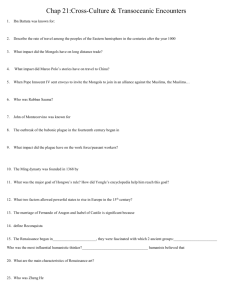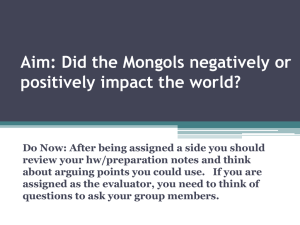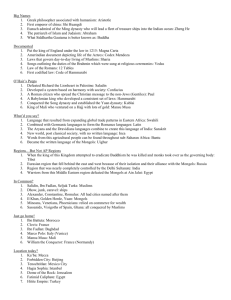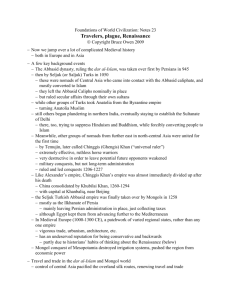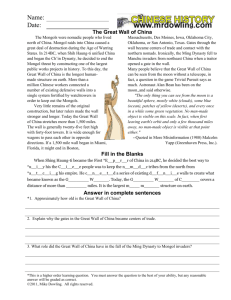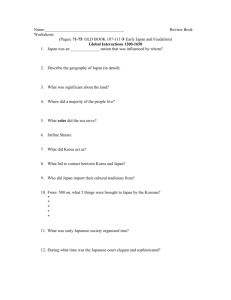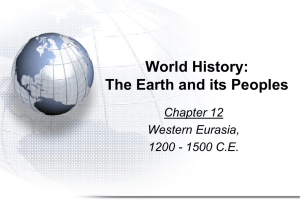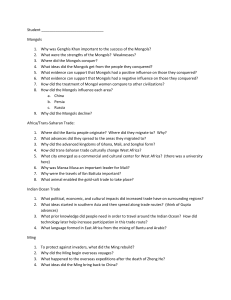this PowerPoint - Mr. Hunsaker's Classes
advertisement
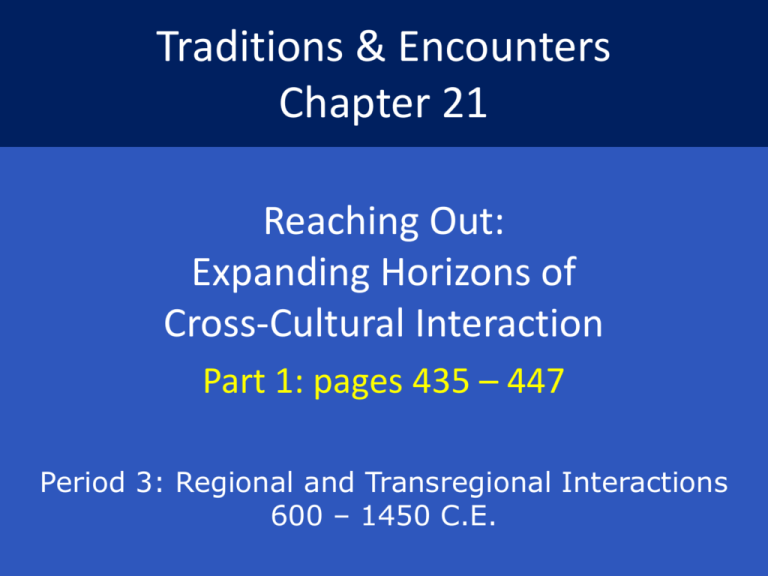
Traditions & Encounters Chapter 21 Reaching Out: Expanding Horizons of Cross-Cultural Interaction Part 1: pages 435 – 447 Period 3: Regional and Transregional Interactions 600 – 1450 C.E. Patterns of Long-Distance Trade • • • • • Silk roads Sea lanes of Indian Ocean basin Trans-Saharan caravan routes Development of trading cities, emporia Nomadic invasions cause local devastation but expand trade network – Example: Mongols in China, thirteenth century Marco Polo (1253-1324) • • • • • Example of long-distance travel Traveled to China with merchant father, uncle Enters service of Mongol Khubilai Khan Returns to Venice after 17-year absence Experiences recorded by fellow prisoner in Venice-Genoa conflict • Great influence on European engagement with far east Political and Diplomatic Travel • Trade requires diplomatic relations after 1000 C.E. • Mongols, Christians recognize Muslims as common enemy, thirteenth century • Pope Innocent IV invites Mongols to convert to Christianity – Mongols counter-offer: Christians accept Mongol rule or face destruction Diplomatic Travelers • Ibn Battuta (1304-1369) – Islamic scholar, worked in governments on extensive travel – Strict punishment meted out according to sharia • Lashes for drinking alcohol, hand amputations for theft • Unable to convince women of Maldive Islands to cover breasts Travels of Marco Polo & Ibn Battuta Missionary Travelers • Sufi missionaries travel throughout new Muslim territories, 1000-1500 C.E. • Christian missionaries accompany, follow crusaders – Roman Catholic priests travel east to serve expatriate communities – John of Montecorvino travels to China in 1291 • Translates Biblical texts, builds churches Spread of Crops • Citrus fruits, Asian rice, cotton • Sugarcane – Muslims introduce crystallized sugar to Europeans – Demand increases rapidly – Europeans use Muslim precedent of having large populations of slaves work on sugarcane plantations Gunpowder Technologies • Muslims, Mongols spread gunpowder • Technology reaches Europe by mid-thirteenth century Crisis and Recovery • “Little ice age,” ca. 1300 C.E. – Decline of agricultural output leads to widespread famine – Bubonic plague spreads from southwest China • Carried by fleas on rodents • Mongol campaigns spread disease to Chinese interior Spread of Plague Mongols, merchants, travelers spread disease west Symptoms of the Black Plague • Inflamed and discolored lymph nodes in neck, armpits, groin area – Buboes, hence bubonic • 60-70% mortality rate, within days of onset of symptoms • Extreme northern climates less affected – Winter hard on flea population • India, sub-Saharan areas unaffected – Reasons unknown Population Declines (millions) Social and Economic Effects • • • • Massive labor shortage Demand for higher wages Population movements Governments attempt to freeze wages, stop serf movements – Riots result

